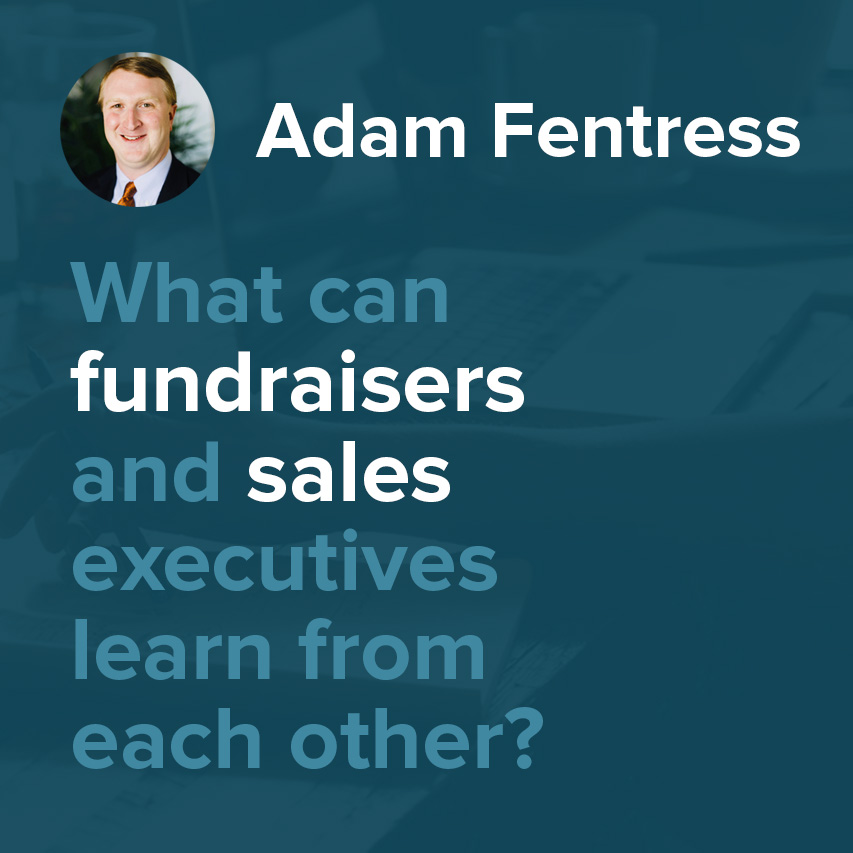We’ve been saying it for years. Now someone who’s been on both sides has chimed in to agree with us.
When fundraising and sales orgs come face to face, they basically look at each other like this:

Adam Fentress of the University of Virginia (who actually joined us for a recent webinar, btw) (oh and he’s also on a panel at EverTrueU this very day) has worked in fundraising for the last two years. Before that he spent the entirety of his career in technology sales. With experience on both sides, he’s discovered some valuable things fundraisers and sales executives could learn from one another.
But mostly he sees similarities.
The article he shared on LinkedIn yesterday was so good, we had to ask him if we could share it on our blog.
He said yes. So here it is.
A colleague recently shared a Chronicle of Philanthropy article about the Rutgers University Foundation’s Office of Talent Management survey on the recruitment of fundraisers, outside of fundraising backgrounds. As someone who entered the fundraising profession (outside of fundraising, from a sales background) this article piqued my curiosity about better-bridging the knowledge gap between fundraising and outside industries—in particular, sales; what can we all learn from each other?
The article opens up with a description of the ideal segment of a non-traditional fundraisers to recruit (based on the survey results): “people who work in sales, who are no more than 12 years out of college, and who give to charity — often to the organization doing the hiring.”
Almost two years into my role in the higher education development field, after spending all of my career in education technology sales prior, it is evident to me that there are certainly fundamental differences between the fundraising and sales process/methodology, but I’ve found many more similarities than differences.
So, the question becomes, what if we are able to build into our fundraiser training programs some of the key ‘intangibles’ that former sales executives may be able to offer a non-profit fundraising organization? This includes key skills like the ability to build natural urgency, communicate with purpose, and have a constant handle on various stages of their pipeline. And, conversely, what sorts of tools that fundraisers leverage could benefit a sales executive? This includes practices like active listening, patience, and empathy.
I outline a few of my key thoughts below:
Key lessons for fundraisers (from a sales perspective)
Building urgency
This is one of the most significant differences, and challenges, in the fundraising processes vs. sales. While you may not have the advantage of a natural urgency lever that can be part of a sales process (e.g. a specific business need, a launch date for a new system, etc.), there are ways to set agreeable time frames with donors based on their internal philanthropic calendar. Sure, end of year gifts for tax purposes help, but this is generally not what is driving a donor’s motivation. Does the donor have an interest in establishing a scholarship? If so, if it is going to take them 5 years to fund, then outlining for the donor the time frames for which the first award will be made to a student based on when they make their first gift can help tie some natural urgency back to their interests.
Communicating with a purpose
Fundraising conversations center on many personal topics for donors, and it is important to take time to appropriately assess interests, capacity, and build a relationship of trust. Though, when you reach out to a donor for an initial meeting, and they see “development” in your signature line, most know what your ultimate goal is, so it is important to express that from the start. Likewise, as conversations progress, agreeing to a follow up timetable creates transparency into your process, and tends to equate to a more transparent donor as they are more open to articulating their intentions. While it is certainly OK to occasionally meet with donors just to say “hi,” the vast majority of meetings should be prefaced with why you would like to meet again—and the goal/outcome of the meeting. Most donors have been successful in their various careers, may have limited time, and appreciate purpose in all communications.
Consistent opportunity/pipeline reviews
Fundraisers at all levels can benefit from their manager, or peers, conducting more in depth pipeline reviews to ask questions about prospects. Many times these meetings center on fundraisers bringing up the key prospects they want to talk about–which tend to be those furthest along in the gift cycle. But, what about bringing up that one prospect where you just had a great discovery meeting and are trying to determine next steps? Or, that prospect that seems to have all of the right signals of a significant donor– but you just can’t figure out what to do next? I believe we can all learn from not only management, but our peers, injecting some fresh ideas that we otherwise may not have thought about with certain prospects. Likewise, fundraising management should leverage technology in meetings with development officers to glance at all of their various stages with the ability to hone in on certain prospects similar to the responsibilities of a sales manager.
Key lessons for sales executives (from a fundraising perspective)
Active and mindful listening
Throughout my sales career, I have heard a lot about the importance of active listening in the prospect lifecycle. But, until I sat down for my first 1:1 development meeting with a donor, I realized that I did not truly know what this meant. In a B2B environment, it is admittedly tough to humanize a buyer when you aren’t viewing them from a “human” lens. Fundraising teaches development officers to truly humanize their prospects, because it is impossible not to—they are talking to donors about their lives, interests, and goals. If, as sales people, we are able to better understand an organization’s issues they are trying to solve, the politics of the organization, and the personalities of the main decision maker(s) then the more satisfied the customer will be.
Patience
Not every deal happens over night, and you cannot make a prospective customer initiate a purchase. Fundraisers are skilled in the art of waiting… this is significantly more difficult for a variety of reasons in sales. As referenced above, if we lose sight of the humanization of customers, then we can maybe push deals that are not in the best interest of the buyer, or the company, for the simple purpose of hitting goals. It is certainly understandable that a sales person needs to work with what they have in their pipeline, but if we rethink how a pipeline is built and put in more effort to actually understand (realistically) the preferred timing of the customer, we can be more patient with deals and add more value to the customer (and even contract value) through refocusing our mindset from quick-wins to long-term, high value solutions.
Empathy
There is so much political capital that employees invest in advocating for particular outside solutions, and they do indeed have multiple hoops to jump through (regardless of level, or type of institution). In former roles, selling into higher education, it was admittedly frustrating when you heard a customer articulate they had made a decision, and were ready to move forward, but yet the purchase was held up internally for a variety of reasons (budget cycle, still need more feedback, it’s on the purchasing office’s desk, etc.). But, now I can see first hand the sorts of issues that can hang up a purchase in higher education directly. I use this specific, first-hand industry example to highlight that if we demonstrate empathy with our customers then we will better understand the day-to-day issues they face. Over time through accumulating various customer situations, you can serve as the coach to help the prospective customer navigate their internal issues.
Final Thoughts
Fundraising and sales should not be grouped together as one profession, as there are clear fundamental differences. But, both professions have a similar process—we reach out to prospects, meet with them, build relationships, assess interests, present proposed options/solutions, and through effective follow up seek to close gifts/deals and bring in revenue for our organizations.
What I hope is that in the fundraising community, we can open up a dialogue about various components of a traditional relationship-based sales process that can influence and create more efficiency in our work. Likewise, I believe there are lessons learned for sales executives when learning more about a fundraisers highly relationship-based, day-to-day work.
